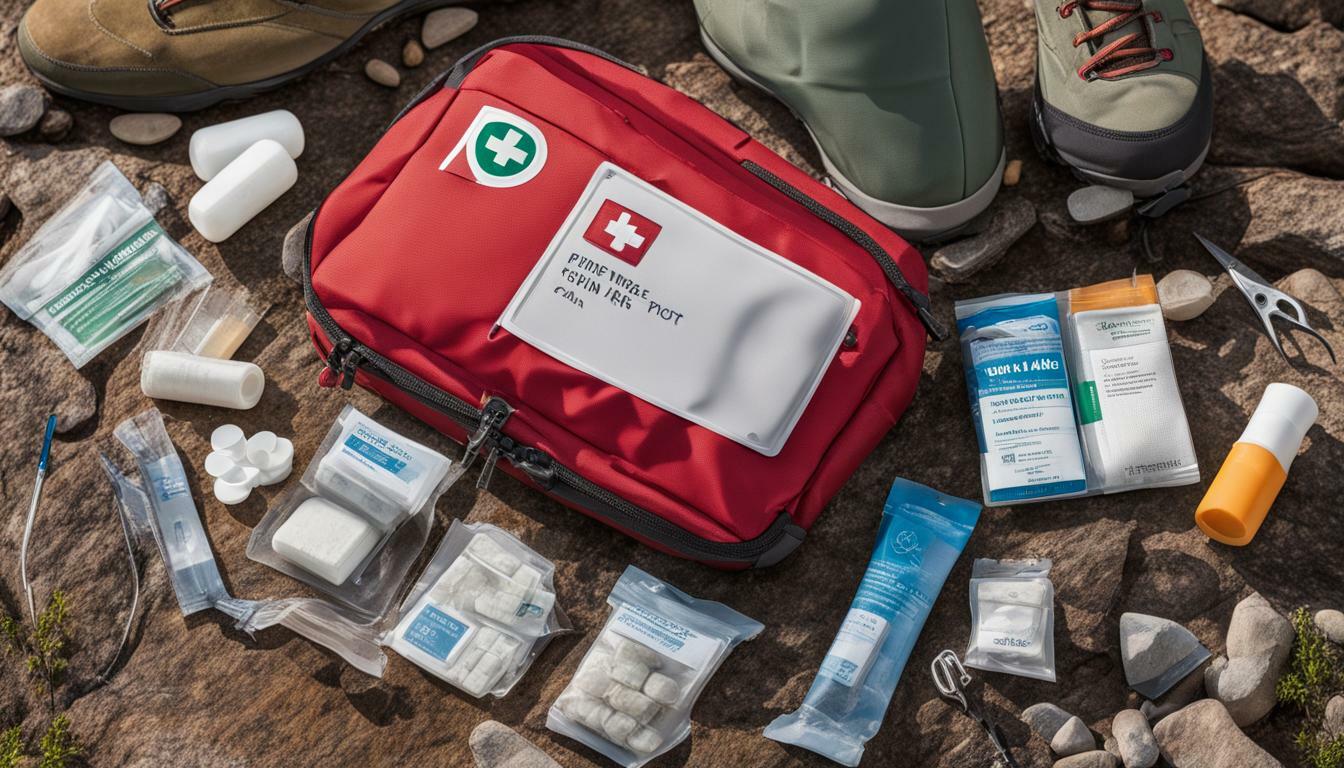Hello and welcome to our guide on foot care for long-distance walkers! If you’re planning to embark on a walking adventure across the UK, it’s essential to consider the health of your feet. Foot fatigue is a common problem among walkers, but there’s no need to worry. By carrying a well-stocked first aid kit with the right items, you can alleviate foot fatigue and prevent further discomfort.
In this section, we will discuss the importance of first aid kits for long-distance walkers and explore the various items that should be included to ensure proper foot care. So, let’s get started on our journey to happy, healthy feet!
Understanding Foot Fatigue
Foot fatigue is a common problem for long-distance walkers. It is a result of the repeated impact on the feet from walking long distances or standing for extended periods. When the feet are overused, they can become sore, swollen, and painful.
There are several causes of foot fatigue, such as wearing ill-fitting shoes, walking on hard surfaces, or carrying heavy loads. It is important to take proper care of your feet to prevent and treat foot fatigue. This involves regular rest, proper footwear and foot care, stretching exercises, and adequate nutrition.
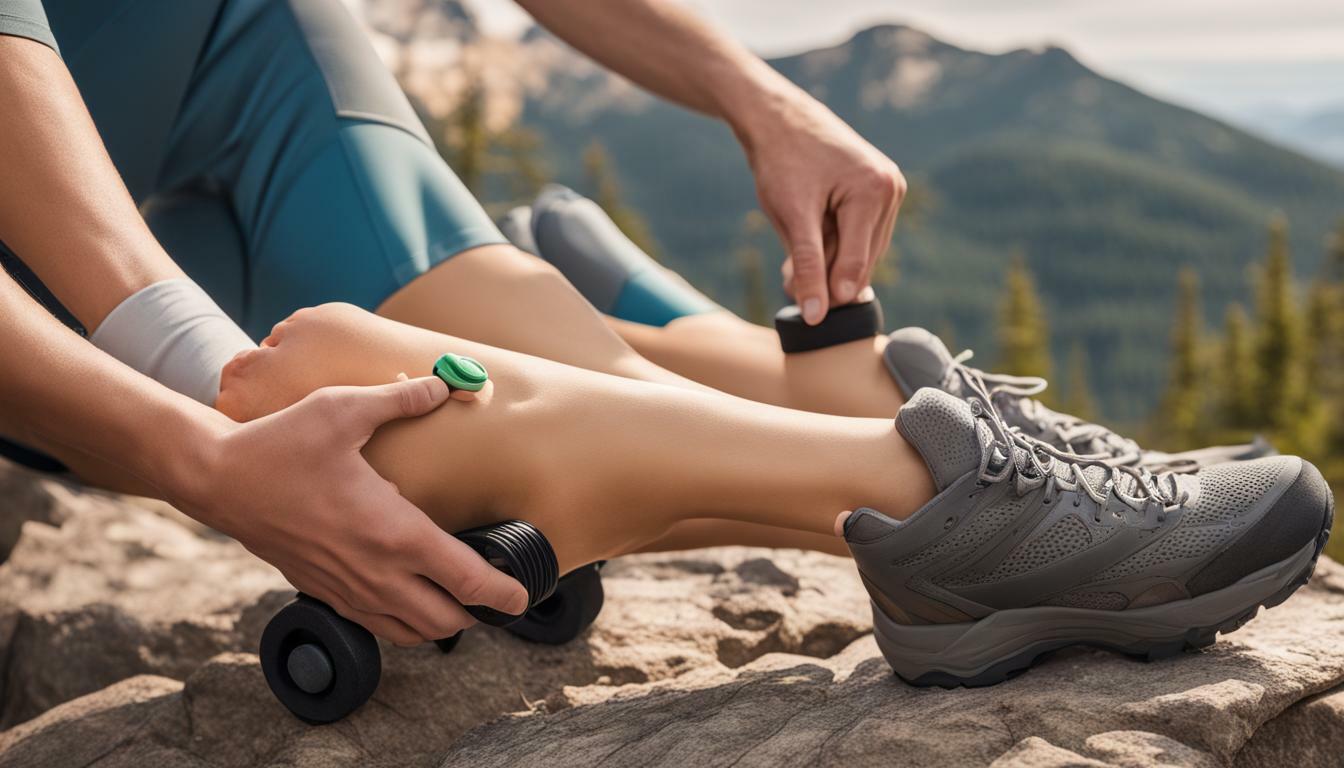
In the next section, we will discuss the key items that should be included in a first aid kit for treating foot fatigue. By carrying these essential items, you can take care of your feet and prevent foot fatigue during your long-distance walks.
Key Items for Foot Fatigue Treatment in First Aid Kits
If you’re planning a long-distance walk, it’s essential to prepare a first aid kit that includes items to prevent and treat foot fatigue. Foot fatigue can often lead to discomfort and pain, hindering your walking adventures. Here are some key items to consider including in your foot fatigue treatment kit for a more enjoyable and pain-free walk:
Blister Prevention
Blisters are one of the most common problems faced by long-distance walkers, and they can significantly affect foot fatigue. Therefore, including blister prevention items in your first aid kit is crucial. Items such as moleskin pads and blister plasters can protect your feet from friction, preventing blisters from forming. These items should be applied before setting off on your adventure.
Pain Relief
Foot fatigue often leads to pain and discomfort. To alleviate foot fatigue symptoms, pain relief products are vital. You can include pain relievers like ibuprofen, which help reduce inflammation. Pain-relieving creams and sprays, which provide a cooling or warming effect, can also help you relax and reduce foot fatigue discomfort.
Other Remedies
There are other remedies you can include in your first aid kit to alleviate foot fatigue symptoms. Arch support inserts, for instance, can help reduce foot strain and prevent further injuries. Toe separators can help realign your toes, reducing discomfort, while compression socks can help improve blood circulation and reduce swelling and pain. Including these remedies in your first aid kit can help you address foot fatigue during your long walks.
By packing the right foot fatigue treatment items in your first aid kit, you can reduce the risk of foot fatigue and make your long-distance walks much more enjoyable. Take some time to review these items and consider what you might need for your next adventure.
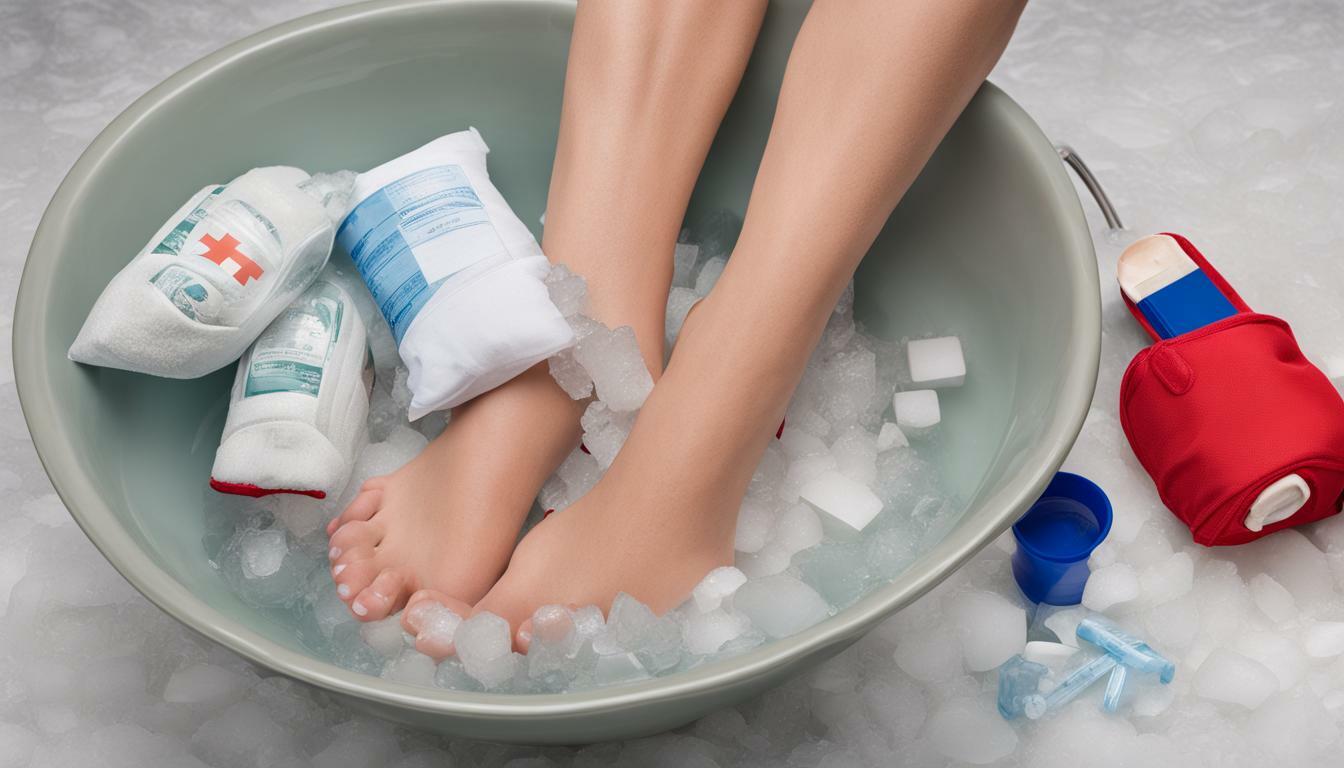
Blister Prevention for Walkers
Long-distance walking can take a toll on your feet, and blisters are a common problem that can cause pain and discomfort. However, there are effective strategies and products you can use to prevent blisters during your walks and reduce foot fatigue. Here are some tips for blister prevention for walkers:
| Tip | Description |
|---|---|
| Choose the right shoes | Wear shoes that fit well and provide ample support. Shoes that are too tight or too loose can cause blisters. |
| Break in new shoes before walking long distances | New shoes can cause blisters, so make sure to break them in before you embark on a long walk. |
| Wear moisture-wicking socks | Sweaty feet can cause blisters, so wear socks made of wicking materials that will keep your feet dry. |
| Use talcum powder or anti-chafing balms | These products can help reduce friction and prevent blisters. |
| Cover hot spots with moleskin or blister patches | If you feel a hot spot forming, cover it with moleskin or a blister patch to prevent it from becoming a blister. |
Proper blister prevention is key to reducing foot fatigue and ensuring a comfortable long-distance walk. By following these tips, you can keep blisters at bay and enjoy your UK adventure with healthy, happy feet.
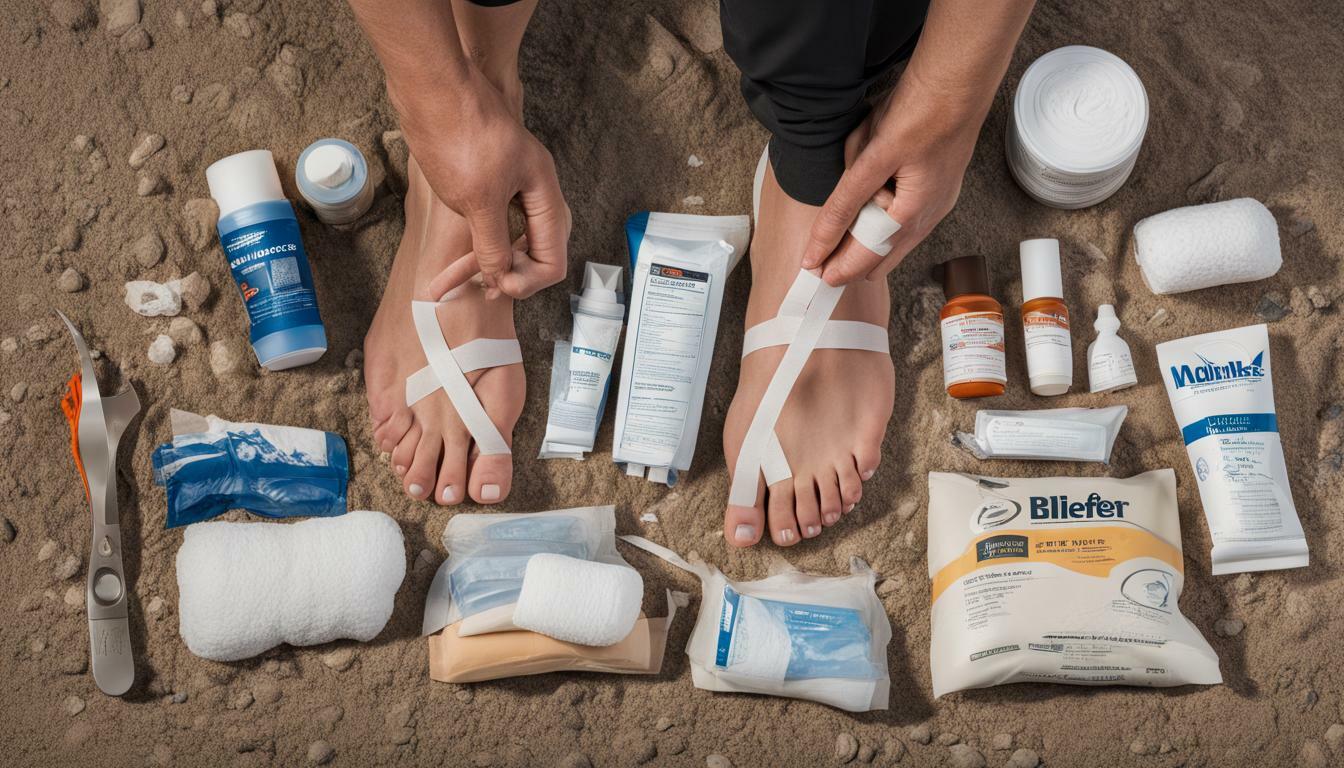
Pain Relief for Foot Fatigue
Foot fatigue can be incredibly painful, but luckily, there are several remedies that can help alleviate discomfort. Here are some essential items to include in your first aid kit for foot fatigue:
1. Pain-Relieving Cream or Gel
A pain-relieving cream or gel can be an effective way to soothe sore, tired feet. Look for products that contain ingredients like menthol, arnica, or capsaicin, which can help reduce pain and inflammation. Apply the cream or gel to your feet and massage gently until it is fully absorbed.
2. Hot/Cold Therapy Options
Another way to ease foot fatigue is through hot/cold therapy. You can use a hot water bottle or heating pad to warm up your feet, which can help increase circulation and reduce soreness. Alternatively, you can place a bag of ice or a cold pack on your feet to reduce inflammation and numb pain.
3. Painkillers
If the pain is particularly severe, over-the-counter painkillers like ibuprofen or acetaminophen can provide relief. However, it’s important to follow the recommended dosage and not rely on painkillers as a long-term solution.
Remember, these pain relief methods are only temporary solutions. If you experience persistent pain or discomfort, it’s important to seek medical attention.
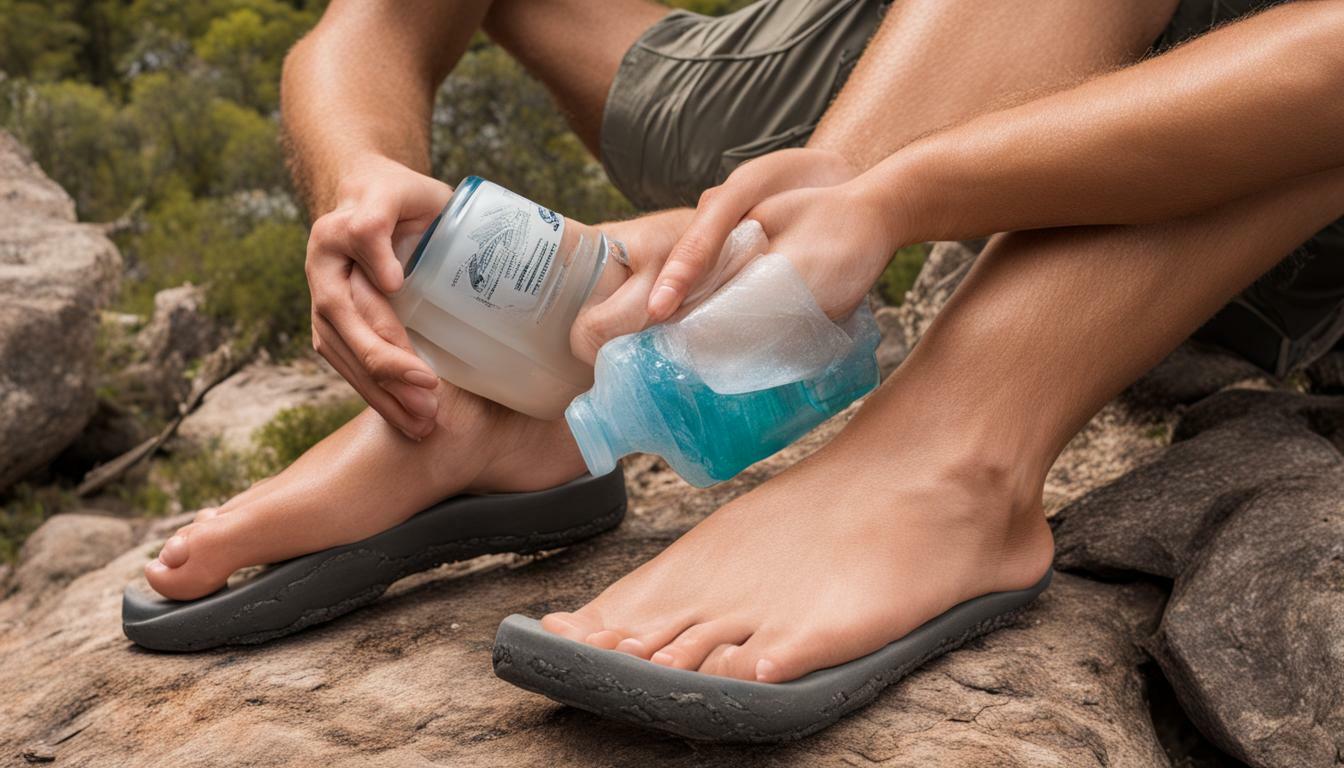
By including these essential items in your first aid kit, you’ll be prepared to address foot fatigue and ensure a more comfortable walking experience. Don’t let foot pain hold you back from enjoying the beautiful UK countryside!
First Aid Supplies for Foot Care
Aside from specific items for foot fatigue, it is important to have general first aid supplies in your kit to address any minor injuries or emergencies that may occur during your long-distance walks. Below are some walking first aid supplies to consider:
| Item | Description |
|---|---|
| Adhesive bandages | For small cuts and blisters |
| Antiseptic wipes | For cleaning wounds and preventing infection |
| Gauze pads | For larger wounds and blisters |
| Tweezers | For removing splinters or debris |
| Pain relievers | For headaches, muscle pain, and other minor aches |
| Emergency whistle | For attracting attention in case of an emergency |
Carrying a well-stocked foot first aid kit can provide peace of mind on your walks and ensure that you are prepared for anything that may come your way.
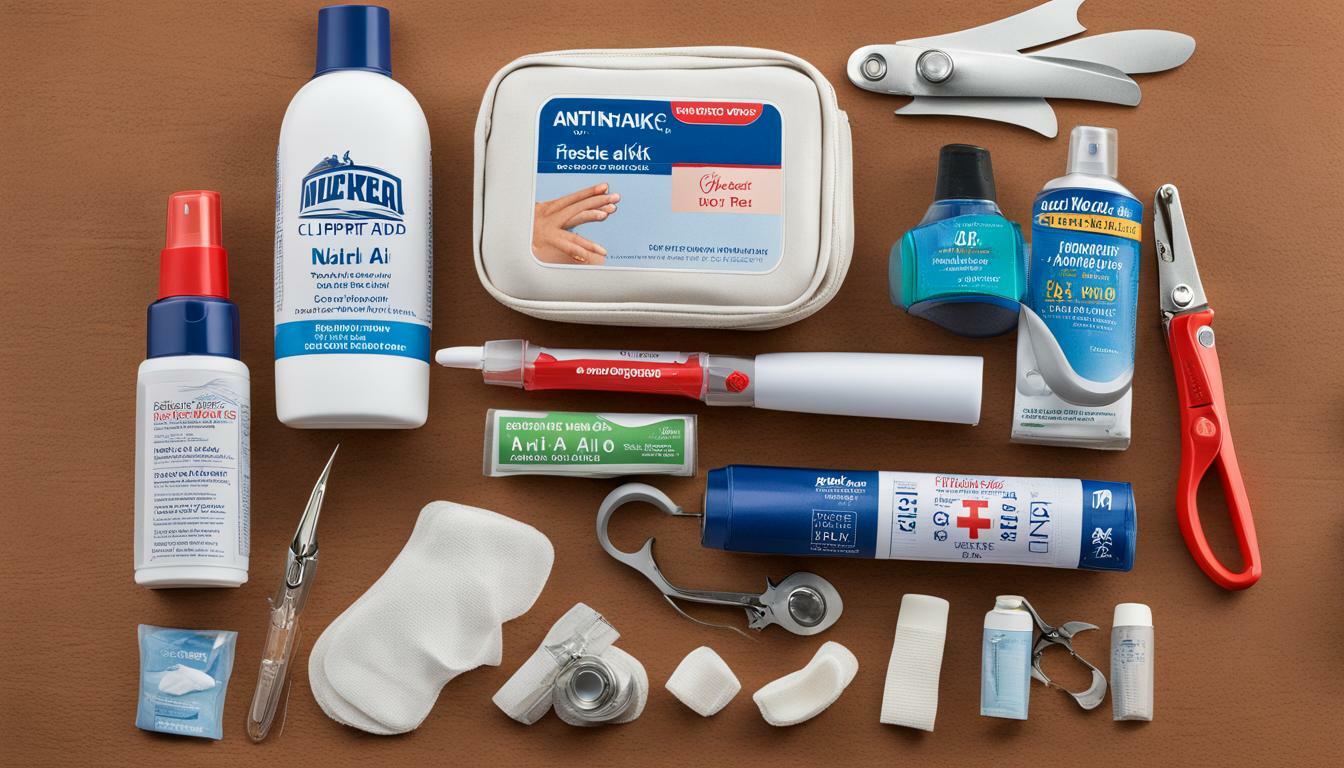
Image depicting essential first aid supplies for long-distance walkers.
Foot Care Essentials for Long-Distance Walking
When embarking on long-distance walks, it’s important to prepare and pack the essentials for foot care. Here are some must-have items to keep your feet healthy and happy:
- Comfortable Footwear: Invest in a good pair of walking shoes that are comfortable, supportive and have ample space for toe movement. Avoid new or ill-fitting shoes that can cause blisters or soreness.
- Moisture-wicking Socks: Look for socks made from synthetic materials that wick moisture away from your feet, reducing the risk of blisters and fungal infections.
- Foot Powder: Use foot powder to help keep your feet dry, reducing friction and preventing blisters.
- Foot Soak: Soaking your feet in warm water can provide relief and relaxation after a long day of walking. Add in some Epsom salt to help reduce inflammation and soreness.
- Ice Pack: An ice pack can reduce inflammation and help alleviate pain or soreness in your feet. Freeze a water bottle and use it as a makeshift ice pack during rest breaks.
By prioritizing foot care essentials, you can reduce the risk of foot injuries and discomfort during your long-distance walks.
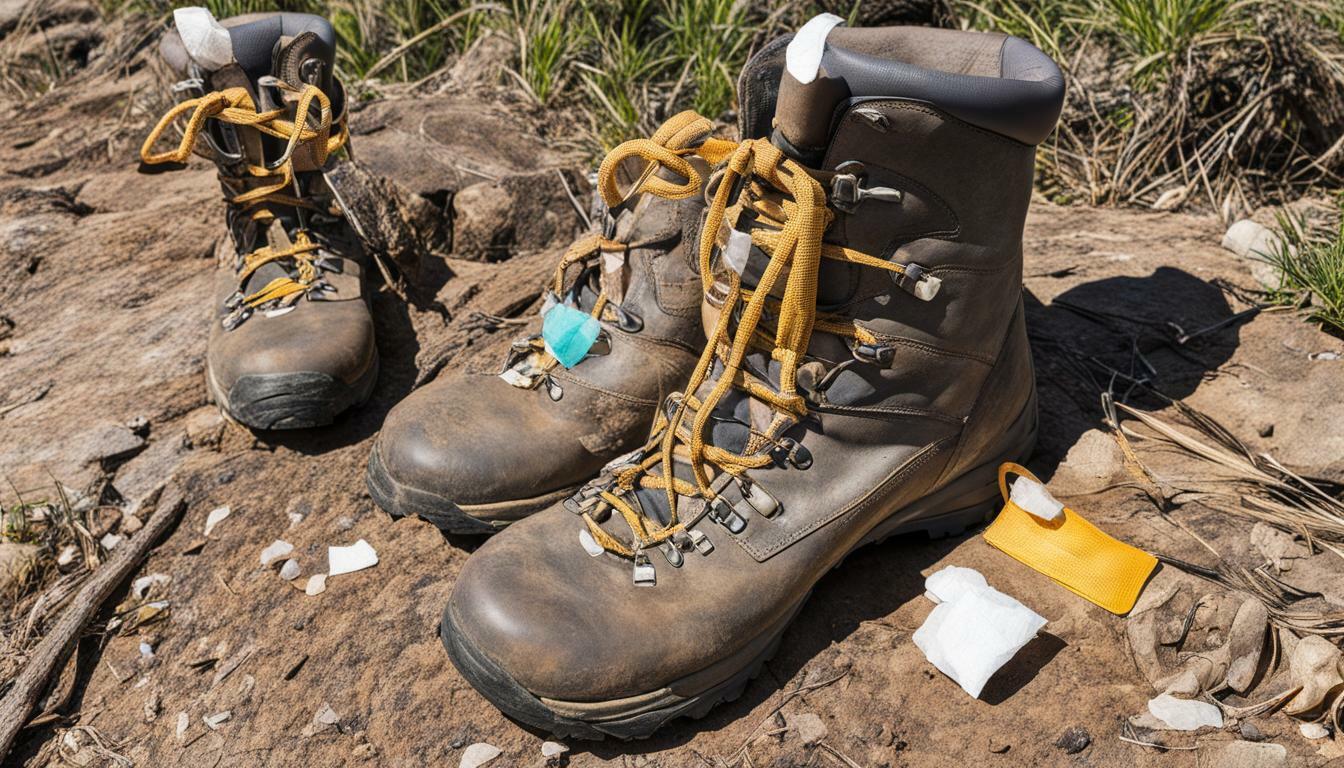
Understanding the Importance of Rest and Recovery
Long-distance walking can be grueling and take a toll on your feet. It’s crucial to rest and recover to prevent foot fatigue and avoid long-term foot problems. Taking breaks, stretching, and other restorative measures can significantly reduce the risk of foot injuries.
The Significance of Taking Breaks
Resting during long-distance walks is essential as it allows your feet to recover from the pressure and strain. The recommended resting time is 10 to 15 minutes every two hours of walking. During this time, it’s best to remove your shoes and let your feet breathe. Elevating your legs can also help reduce swelling and increase blood flow to your feet.
Stretching Exercises for Foot Care
Stretching before and after a long walk is critical for preventing foot fatigue. Some excellent stretching exercises for your feet include toe curls, ankle rolls, and calf stretches. Strengthening exercises can also help build foot muscles and prevent foot injuries. It’s essential to consult a professional foot therapist to learn the right exercises for your feet.
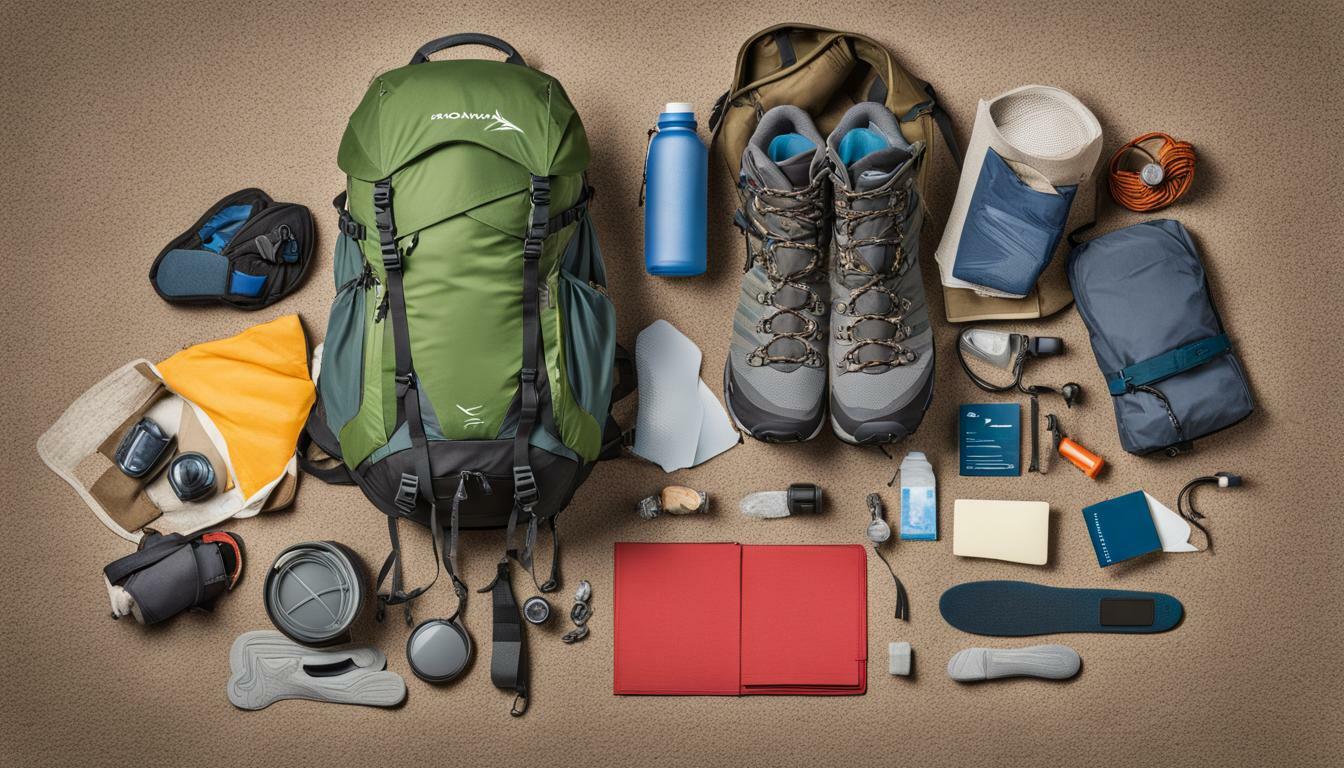
Other Restorative Measures
Other restorative measures include proper sleep, maintaining a healthy diet, and hydration. Getting adequate sleep helps your feet recover from stress and strain. A balanced diet that includes sufficient vitamins and minerals helps keep your feet healthy. Proper hydration ensures your feet have enough moisture during long walks.
When it comes to long-distance walking essentials, those that focus on rest and recovery are a must-have. Taking breaks, stretching exercises, and other restorative measures ensure that you remain in top condition for your adventure.
Proper Techniques for Foot Care
Proper foot care techniques can help prevent foot fatigue and discomfort during long-distance walks. Here are some tips to keep your feet healthy and happy:
- Cleanliness: Keep your feet clean and dry to prevent bacterial and fungal infections. Wash your feet daily with soap and water, and dry them thoroughly, especially between the toes.
- Moisturizing: Apply moisturizing cream or lotion to the tops and bottoms of your feet to prevent dry skin, cracking, and calluses.
- Nail Trimming: Trim your toenails straight across and avoid rounding the corners to prevent ingrown toenails. Use a sharp nail clipper and gently file the edges.
- Proper Footwear: Wear comfortable shoes that fit well and provide proper support. Choose shoes with a wide toe box to avoid cramming your toes together, and make sure they are breathable to prevent excessive sweating and odor.
- Stretching: Stretch your feet and toes before and after your walk to prevent muscle fatigue and injury. Try rolling a tennis ball or frozen water bottle under your foot to massage and stretch the muscles.
- Blisters: If you feel a hot spot or blister forming, cover it with a blister plaster or moleskin to prevent it from getting worse. Avoid popping the blister, as this can lead to infection.
- Taping: If you are prone to blisters, use special sports tape to cover areas that are prone to friction, such as the heels and toes.
By following these proper techniques for foot care, you can help prevent foot fatigue and discomfort during your long-distance walks.
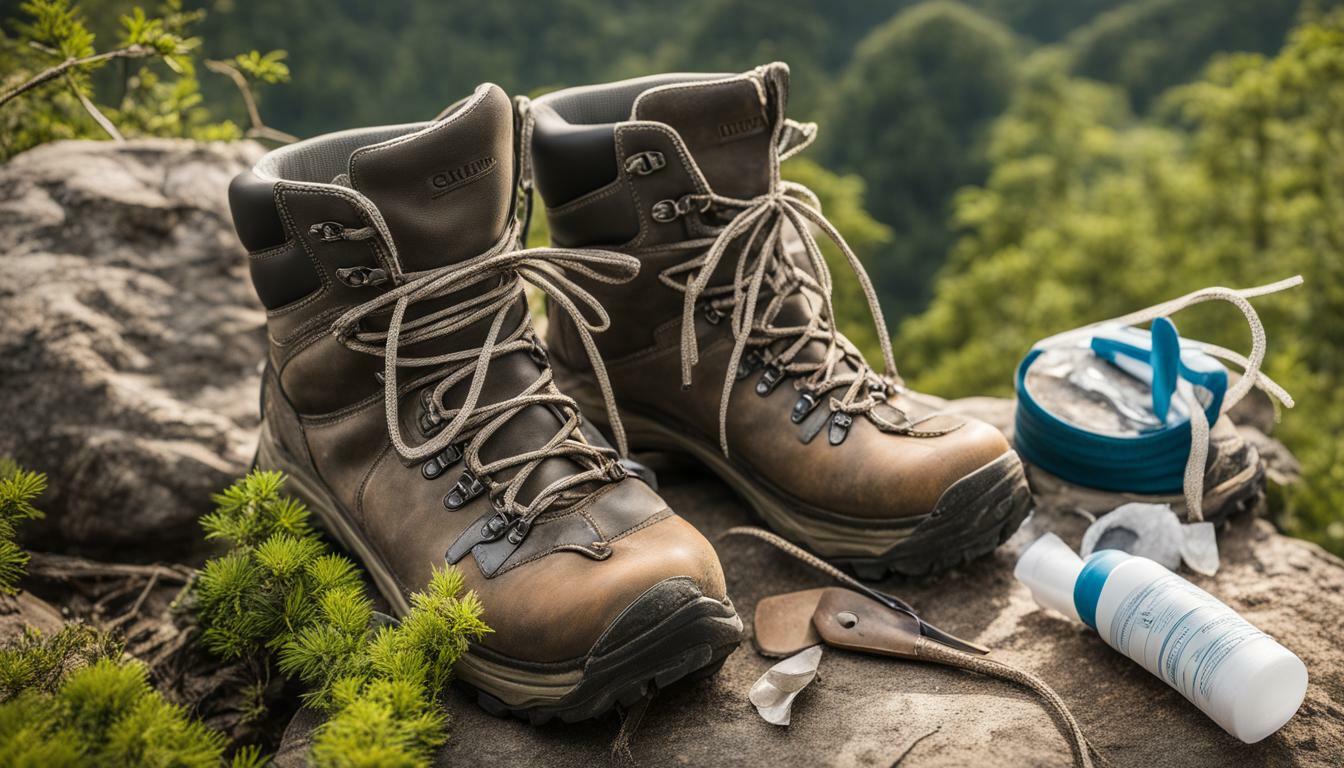
The Role of Nutrition in Foot Care
While proper foot care is essential for long-distance walkers, nutrition plays a significant role in foot health and overall endurance. A balanced diet with the right nutrients can support foot health, reduce fatigue, and prevent injury.
Hydration is crucial for foot health and endurance. Drinking enough water throughout your walks helps keep your feet hydrated and reduces the risk of blisters. Electrolyte drinks can help replenish fluids lost through sweating and provide an energy boost.
Calcium and Vitamin D are essential for strong bones and can help prevent stress fractures, which are common among long-distance walkers. Good sources of calcium include dairy products, leafy greens, and fortified foods. Vitamin D can be obtained from sunlight and foods such as fatty fish and fortified dairy products.
Omega-3 fatty acids, found in fish, nuts, and seeds, have anti-inflammatory properties that can reduce inflammation and pain in the feet and joints.
Iron is crucial for oxygen transport in the body. A deficiency in iron can lead to fatigue and weakness. Good sources of iron include red meat, beans, and leafy greens.
Finally, consuming carbohydrates before and during your walks can provide energy and delay fatigue. Carbohydrates can be found in foods such as pasta, bread, and fruit. It is important to choose complex carbohydrates for sustained energy.

By paying attention to nutrition and including the right foods in your diet, you can support your foot health and reduce the risk of injury and fatigue.
Staying Prepared: Regular Check-ups and Maintenance
Long-distance walking can take a toll on your feet, so it’s important to stay proactive with regular check-ups and maintenance. A podiatrist can assess any potential problems or injuries before they become serious issues, and can also recommend specific foot care products or techniques tailored to your needs.
In addition to professional check-ups, regular maintenance is essential. Be sure to keep your toenails trimmed and clean, moisturize regularly, and stretch your feet and calves before and after your walks. Regular massage and foam rolling can also help alleviate foot fatigue and soreness.
By staying on top of regular check-ups and maintenance, you can prevent potential foot problems and ensure that your feet are healthy and ready for your next long-distance walking adventure.
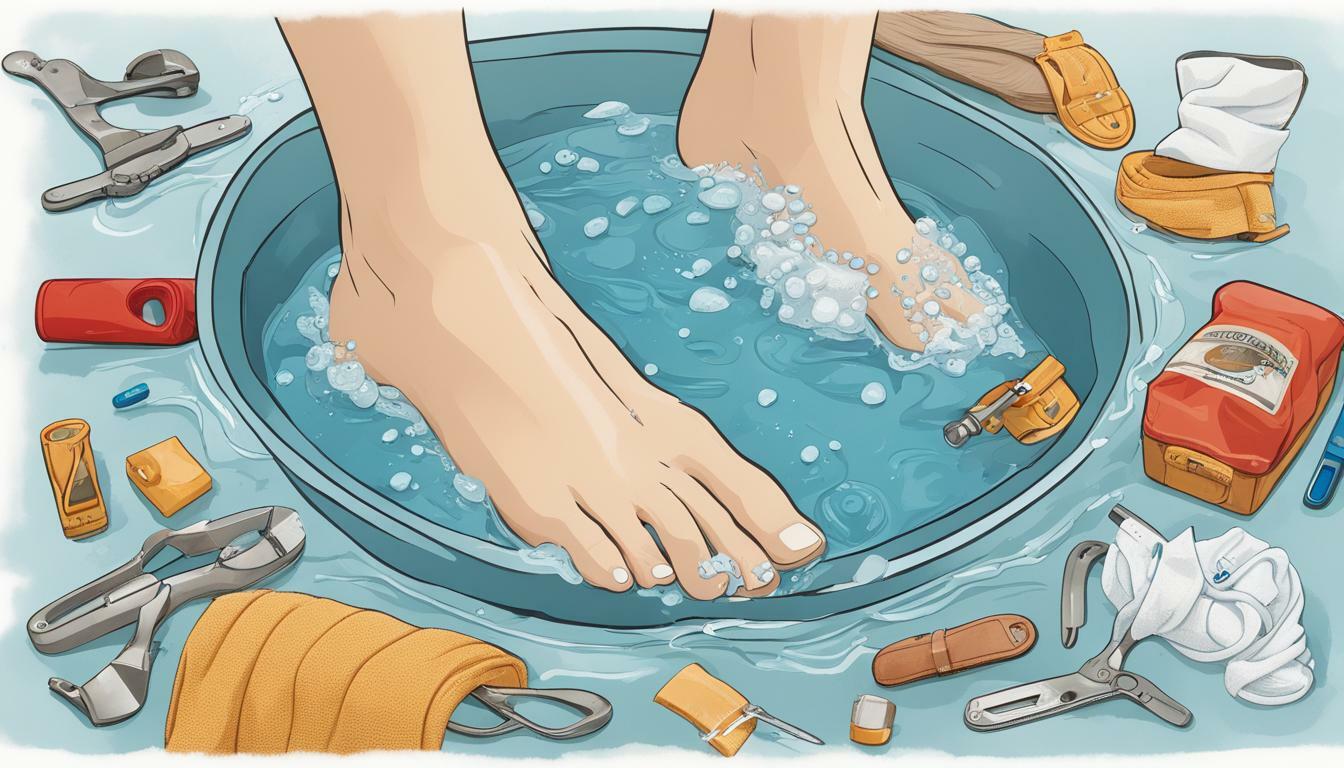
Conclusion
When it comes to long-distance walking, proper foot care is essential to prevent foot fatigue and discomfort. Carrying a well-stocked first aid kit with key items for foot fatigue treatment and blister prevention is crucial. Along with first aid supplies, there are other essentials that walkers should carry, such as comfortable footwear and moisture-wicking socks.
Rest and recovery are also important for preventing foot fatigue. Taking breaks, stretching exercises, and other methods can give your feet the rest they need during long walks. Additionally, proper hygiene practices and taping methods for blister prevention are essential techniques for foot care.
Walkers should also pay attention to their nutrition and hydration, as a balanced diet plays a crucial role in supporting foot health and reducing fatigue. Regular check-ups and maintenance by a professional are also necessary to keep your feet in top condition throughout your walking adventures.
With these tips and strategies, walkers can enjoy their UK adventures with healthier, happier feet. So, remember to take care of your feet and carry a well-stocked first aid kit on your next long-distance walk.
